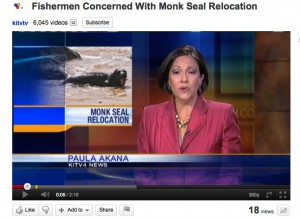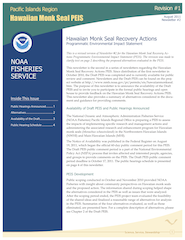Media Watch, Maui News, 17 September 2011
A federal plan to help the survival of the endangered monk seal population ran into stiff opposition Thursday night, especially from Hana fishermen and Native Hawaiians concerned the proposed regulations would hamper their ability to fish.
“Fishing is not a sport in Hana,” said 16-year-old Malia Kahuhu. “We need these fish to eat.” […]
Those speaking out said the draft regulations could lead to closed-off ocean “iceboxes” – just to accommodate the fish-eating seals they compete with for their supper.
However, National Oceanic and Atmospheric Administration officials responded that their proposals would not create closures or restrictions.
Instead, NOAA Marine Mammal Branch Chief Jeff Walters said officials are looking at relocating the seals to promote their reproduction. And, they want to create community partnerships, such as working with fishermen to find sick seals, he added. [Continues]
Source: Opposition to monk seal plan voiced at meeting, by Chris Hamilton, Maui News, 17 September 2011
![]() Leah R. Gerber, James Estes, Tara Gancos Crawford, Lindsey E. Peavey, Andrew J. Read. 2011. Managing for extinction? Conflicting conservation objectives in a large marine reserve. Conservation Letters 00 (2011) 1–6. DOI: 10.1111/j.1755-263X.2011.00197.x [PDF 238 KB]
Leah R. Gerber, James Estes, Tara Gancos Crawford, Lindsey E. Peavey, Andrew J. Read. 2011. Managing for extinction? Conflicting conservation objectives in a large marine reserve. Conservation Letters 00 (2011) 1–6. DOI: 10.1111/j.1755-263X.2011.00197.x [PDF 238 KB]

 NOAA has released a revised newsletter for the Hawaiian Monk Seal Recovery Actions Programmatic Impact Statement (PEIS). In an accompanying explanation, NOAA states: “The revisions aim to provide clearer language about the proposed alternatives evaluated in the PEIS. Language was changed on page 2 of the newsletter to clarify what Alternatives 1, 2, and 3 would not include.”
NOAA has released a revised newsletter for the Hawaiian Monk Seal Recovery Actions Programmatic Impact Statement (PEIS). In an accompanying explanation, NOAA states: “The revisions aim to provide clearer language about the proposed alternatives evaluated in the PEIS. Language was changed on page 2 of the newsletter to clarify what Alternatives 1, 2, and 3 would not include.” Editor’s Note: Despite oft-reapeated calls for monk seal conservation and science to find a wider public audience — thereby spurring efforts to save the species and its habitat — most research continues to be published in closed access “subscription-only” scientific journals with a limited circulation. In view of this issue’s importance to the survival of the Mediterranean and Hawaiian monk seal, we take this opportunity of drawing our readers’ attention to the following article, “The Lairds of Learning”.
Editor’s Note: Despite oft-reapeated calls for monk seal conservation and science to find a wider public audience — thereby spurring efforts to save the species and its habitat — most research continues to be published in closed access “subscription-only” scientific journals with a limited circulation. In view of this issue’s importance to the survival of the Mediterranean and Hawaiian monk seal, we take this opportunity of drawing our readers’ attention to the following article, “The Lairds of Learning”.